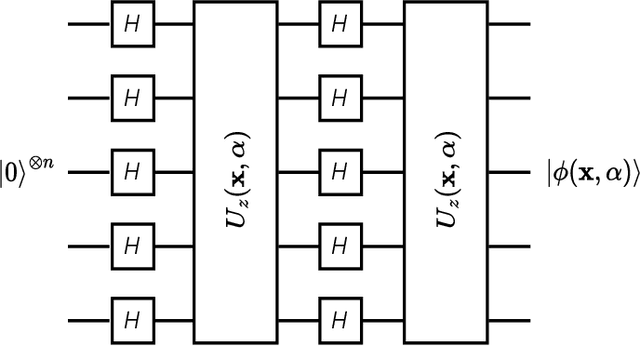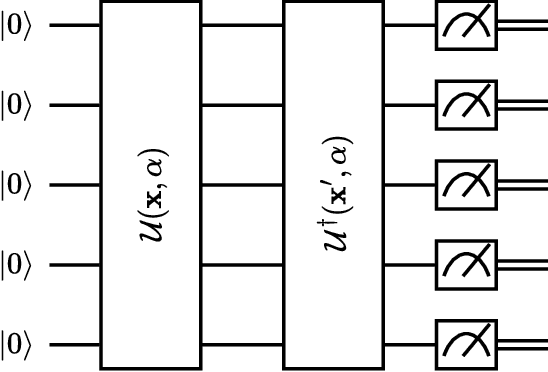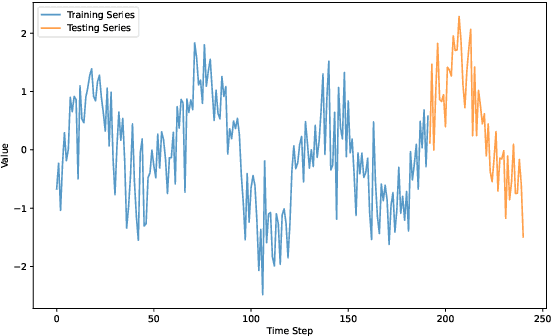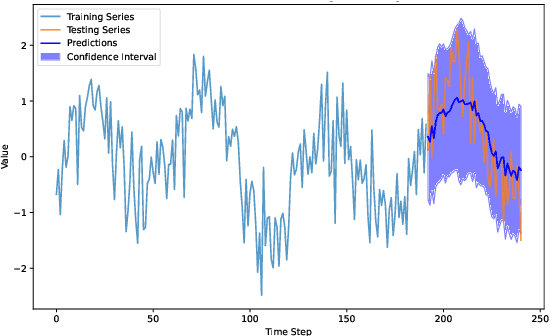Soumaya Cherkaoui
Quantum Gated Recurrent GAN with Gaussian Uncertainty for Network Anomaly Detection
Oct 30, 2025Abstract:Anomaly detection in time-series data is a critical challenge with significant implications for network security. Recent quantum machine learning approaches, such as quantum kernel methods and variational quantum circuits, have shown promise in capturing complex data distributions for anomaly detection but remain constrained by limited qubit counts. We introduce in this work a novel Quantum Gated Recurrent Unit (QGRU)-based Generative Adversarial Network (GAN) employing Successive Data Injection (SuDaI) and a multi-metric gating strategy for robust network anomaly detection. Our model uniquely utilizes a quantum-enhanced generator that outputs parameters (mean and log-variance) of a Gaussian distribution via reparameterization, combined with a Wasserstein critic to stabilize adversarial training. Anomalies are identified through a novel gating mechanism that initially flags potential anomalies based on Gaussian uncertainty estimates and subsequently verifies them using a composite of critic scores and reconstruction errors. Evaluated on benchmark datasets, our method achieves a high time-series aware F1 score (TaF1) of 89.43% demonstrating superior capability in detecting anomalies accurately and promptly as compared to existing classical and quantum models. Furthermore, the trained QGRU-WGAN was deployed on real IBM Quantum hardware, where it retained high anomaly detection performance, confirming its robustness and practical feasibility on current noisy intermediate-scale quantum (NISQ) devices.
Federated Learning-based MARL for Strengthening Physical-Layer Security in B5G Networks
Jul 09, 2025Abstract:This paper explores the application of a federated learning-based multi-agent reinforcement learning (MARL) strategy to enhance physical-layer security (PLS) in a multi-cellular network within the context of beyond 5G networks. At each cell, a base station (BS) operates as a deep reinforcement learning (DRL) agent that interacts with the surrounding environment to maximize the secrecy rate of legitimate users in the presence of an eavesdropper. This eavesdropper attempts to intercept the confidential information shared between the BS and its authorized users. The DRL agents are deemed to be federated since they only share their network parameters with a central server and not the private data of their legitimate users. Two DRL approaches, deep Q-network (DQN) and Reinforce deep policy gradient (RDPG), are explored and compared. The results demonstrate that RDPG converges more rapidly than DQN. In addition, we demonstrate that the proposed method outperforms the distributed DRL approach. Furthermore, the outcomes illustrate the trade-off between security and complexity.
Optimizing Cognitive Networks: Reinforcement Learning Meets Energy Harvesting Over Cascaded Channels
Jul 09, 2025Abstract:This paper presents a reinforcement learning (RL) based approach to improve the physical layer security (PLS) of an underlay cognitive radio network (CRN) over cascaded channels. These channels are utilized in highly mobile networks such as cognitive vehicular networks (CVN). In addition, an eavesdropper aims to intercept the communications between secondary users (SUs). The SU receiver has full-duplex and energy harvesting capabilities to generate jamming signals to confound the eavesdropper and enhance security. Moreover, the SU transmitter extracts energy from ambient radio frequency signals in order to power subsequent transmissions to its intended receiver. To optimize the privacy and reliability of the SUs in a CVN, a deep Q-network (DQN) strategy is utilized where multiple DQN agents are required such that an agent is assigned at each SU transmitter. The objective for the SUs is to determine the optimal transmission power and decide whether to collect energy or transmit messages during each time period in order to maximize their secrecy rate. Thereafter, we propose a DQN approach to maximize the throughput of the SUs while respecting the interference threshold acceptable at the receiver of the primary user. According to our findings, our strategy outperforms two other baseline strategies in terms of security and reliability.
Maximizing Reliability in Overlay Radio Networks with Time Switching and Power Splitting Energy Harvesting
Jul 09, 2025Abstract:Cognitive radio networks (CRNs) are acknowledged for their ability to tackle the issue of spectrum under-utilization. In the realm of CRNs, this paper investigates the energy efficiency issue and addresses the critical challenge of optimizing system reliability for overlay CRN access mode. Randomly dispersed secondary users (SUs) serving as relays for primary users (PUs) are considered, in which one of these relays is designated to harvest energy through the time switching-energy harvesting (EH) protocol. Moreover, this relay amplifies-and-forwards (AF) the PU's messages and broadcasts them along with its own across cascaded $\kappa$-$\mu$ fading channels. The power splitting protocol is another EH approach utilized by the SU and PU receivers to enhance the amount of energy in their storage devices. In addition, the SU transmitters and the SU receiver are deployed with multiple antennas for reception and apply the maximal ratio combining approach. The outage probability is utilized to assess both networks' reliability. Then, an energy efficiency evaluation is performed to determine the effectiveness of EH on the system. Finally, an optimization problem is provided with the goal of maximizing the data rate of the SUs by optimizing the time switching and the power allocation parameters of the SU relay.
Performance Optimization of Energy-Harvesting Underlay Cognitive Radio Networks Using Reinforcement Learning
May 20, 2025Abstract:In this paper, a reinforcement learning technique is employed to maximize the performance of a cognitive radio network (CRN). In the presence of primary users (PUs), it is presumed that two secondary users (SUs) access the licensed band within underlay mode. In addition, the SU transmitter is assumed to be an energy-constrained device that requires harvesting energy in order to transmit signals to their intended destination. Therefore, we propose that there are two main sources of energy; the interference of PUs' transmissions and ambient radio frequency (RF) sources. The SU will select whether to gather energy from PUs or only from ambient sources based on a predetermined threshold. The process of energy harvesting from the PUs' messages is accomplished via the time switching approach. In addition, based on a deep Q-network (DQN) approach, the SU transmitter determines whether to collect energy or transmit messages during each time slot as well as selects the suitable transmission power in order to maximize its average data rate. Our approach outperforms a baseline strategy and converges, as shown by our findings.
Enhancing Network Anomaly Detection with Quantum GANs and Successive Data Injection for Multivariate Time Series
May 16, 2025Abstract:Quantum computing may offer new approaches for advancing machine learning, including in complex tasks such as anomaly detection in network traffic. In this paper, we introduce a quantum generative adversarial network (QGAN) architecture for multivariate time-series anomaly detection that leverages variational quantum circuits (VQCs) in combination with a time-window shifting technique, data re-uploading, and successive data injection (SuDaI). The method encodes multivariate time series data as rotation angles. By integrating both data re-uploading and SuDaI, the approach maps classical data into quantum states efficiently, helping to address hardware limitations such as the restricted number of available qubits. In addition, the approach employs an anomaly scoring technique that utilizes both the generator and the discriminator output to enhance the accuracy of anomaly detection. The QGAN was trained using the parameter shift rule and benchmarked against a classical GAN. Experimental results indicate that the quantum model achieves a accuracy high along with high recall and F1-scores in anomaly detection, and attains a lower MSE compared to the classical model. Notably, the QGAN accomplishes this performance with only 80 parameters, demonstrating competitive results with a compact architecture. Tests using a noisy simulator suggest that the approach remains effective under realistic noise-prone conditions.
LatentQGAN: A Hybrid QGAN with Classical Convolutional Autoencoder
Sep 22, 2024



Abstract:Quantum machine learning consists in taking advantage of quantum computations to generate classical data. A potential application of quantum machine learning is to harness the power of quantum computers for generating classical data, a process essential to a multitude of applications such as enriching training datasets, anomaly detection, and risk management in finance. Given the success of Generative Adversarial Networks in classical image generation, the development of its quantum versions has been actively conducted. However, existing implementations on quantum computers often face significant challenges, such as scalability and training convergence issues. To address these issues, we propose LatentQGAN, a novel quantum model that uses a hybrid quantum-classical GAN coupled with an autoencoder. Although it was initially designed for image generation, the LatentQGAN approach holds potential for broader application across various practical data generation tasks. Experimental outcomes on both classical simulators and noisy intermediate scale quantum computers have demonstrated significant performance enhancements over existing quantum methods, alongside a significant reduction in quantum resources overhead.
QuaCK-TSF: Quantum-Classical Kernelized Time Series Forecasting
Aug 21, 2024



Abstract:Forecasting in probabilistic time series is a complex endeavor that extends beyond predicting future values to also quantifying the uncertainty inherent in these predictions. Gaussian process regression stands out as a Bayesian machine learning technique adept at addressing this multifaceted challenge. This paper introduces a novel approach that blends the robustness of this Bayesian technique with the nuanced insights provided by the kernel perspective on quantum models, aimed at advancing quantum kernelized probabilistic forecasting. We incorporate a quantum feature map inspired by Ising interactions and demonstrate its effectiveness in capturing the temporal dependencies critical for precise forecasting. The optimization of our model's hyperparameters circumvents the need for computationally intensive gradient descent by employing gradient-free Bayesian optimization. Comparative benchmarks against established classical kernel models are provided, affirming that our quantum-enhanced approach achieves competitive performance.
MistralBSM: Leveraging Mistral-7B for Vehicular Networks Misbehavior Detection
Jul 26, 2024



Abstract:Vehicular networks are exposed to various threats resulting from malicious attacks. These threats compromise the security and reliability of communications among road users, thereby jeopardizing road and traffic safety. One of the main vectors of these attacks within vehicular networks is misbehaving vehicles. To address this challenge, we propose deploying a pretrained Large Language Model (LLM)-empowered Misbehavior Detection System (MDS) within an edge-cloud detection framework. Specifically, we fine-tune Mistral-7B, a state-of-the-art LLM, as the edge component to enable real-time detection, whereas a larger LLM deployed in the cloud can conduct a more comprehensive analysis. Our experiments conducted on the extended VeReMi dataset demonstrate Mistral-7B's superior performance, achieving 98\% accuracy compared to other LLMs such as LLAMA2-7B and RoBERTa. Additionally, we investigate the impact of window size on computational costs to optimize deployment efficiency. Leveraging LLMs in MDS shows interesting results in improving the detection of vehicle misbehavior, consequently strengthening vehicular network security to ensure the safety of road users.
FedPylot: Navigating Federated Learning for Real-Time Object Detection in Internet of Vehicles
Jun 05, 2024



Abstract:The Internet of Vehicles (IoV) emerges as a pivotal component for autonomous driving and intelligent transportation systems (ITS), by enabling low-latency big data processing in a dense interconnected network that comprises vehicles, infrastructures, pedestrians and the cloud. Autonomous vehicles are heavily reliant on machine learning (ML) and can strongly benefit from the wealth of sensory data generated at the edge, which calls for measures to reconcile model training with preserving the privacy of sensitive user data. Federated learning (FL) stands out as a promising solution to train sophisticated ML models in vehicular networks while protecting the privacy of road users and mitigating communication overhead. This paper examines the federated optimization of the cutting-edge YOLOv7 model to tackle real-time object detection amid data heterogeneity, encompassing unbalancedness, concept drift, and label distribution skews. To this end, we introduce FedPylot, a lightweight MPI-based prototype to simulate federated object detection experiments on high-performance computing (HPC) systems, where we safeguard server-client communications using hybrid encryption. Our study factors in accuracy, communication cost, and inference speed, thereby presenting a balanced approach to the challenges faced by autonomous vehicles. We demonstrate promising results for the applicability of FL in IoV and hope that FedPylot will provide a basis for future research into federated real-time object detection. The source code is available at https://github.com/cyprienquemeneur/fedpylot.
 Add to Chrome
Add to Chrome Add to Firefox
Add to Firefox Add to Edge
Add to Edge